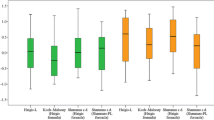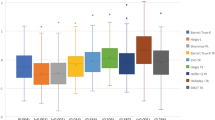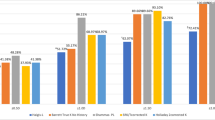Abstract
Purpose
To evaluate the prediction accuracy of the intraocular lens (IOL) power calculation using adjusted corneal power according to the posterior/anterior corneal curvature radii ratio in the Haigis formula (Haigis-E) in patients with a history of prior myopic laser vision correction.
Methods
Seventy eyes from 70 cataract patients who underwent cataract surgery and had a history of myopic laser vision correction were enrolled. The adjusted corneal power obtained with conventional keratometry (K) was calculated using the posterior/anterior corneal curvature radii ratio measured by a single Scheimpflug camera. In eyes longer than 25.0 mm, half of the Wang-Koch (WK) adjustment was applied. The median absolute error (MedAE) and the percentage of eyes that achieved a postoperative refractive prediction error within ± 0.50 diopters (D) based on the Haigis-E method was compared with those in the Shammas, Haigis-L, and Barrett True-K no-history methods.
Results
The MedAE predicted using the Haigis-E (0.33 D) was significantly smaller than that obtained using the Shammas (0.44 D), Haigis-L (0.43 D), and Barrett True-K (0.44 D) methods (P < 0.001, P = 0.001, and P = 0.014, respectively). The percentage of eyes within ± 0.50 D of refractive prediction error using the Haigis-E (78.6%) was significantly greater than that produced using the Shammas (57.1%), Haigis-L (58.6%), and Barrett True-K (61.4%) methods (P = 0.025).
Conclusion
IOL power calculation using the adjusted corneal power according to the posterior/anterior corneal curvature radii ratio and modified WK adjustment in the Haigis formula could improve the refraction prediction accuracy after cataract surgery in eyes with prior myopic laser vision correction.


Similar content being viewed by others
References
Wu Y, Liu S, Liao R (2017) Prediction accuracy of intraocular lens power calculation methods after laser refractive surgery. BMC Ophthalmol 17:44
Aramberri J (2003) Intraocular lens power calculation after corneal refractive surgery: double-K method. J Cataract Refract Surg 29:2063–2068
Shammas HJ, Shammas MC (2007) No-history method of intraocular lens power calculation for cataract surgery after myopic laser in situ keratomileusis. J Cataract Refract Surg 33:31–36
Haigis W (2008) Intraocular lens calculation after refractive surgery for myopia: Haigis-L formula. J Cataract Refract Surg 34:1658–1663
Savini G, Hoffer KJ (2018) Intraocular lens power calculation in eyes with previous corneal refractive surgery. Eye Vision (London, England) 5:18
Olsen T (1986) On the calculation of power from curvature of the cornea. Br J Ophthalmol 70:152–154
Kim M, Eom Y, Lee H, Suh YW, Song JS, Kim HM (2018) Use of the posterior/anterior corneal curvature radii ratio to improve the accuracy of intraocular lens power calculation: Eom’s adjustment method. Invest Ophthalmol Vis Sci 59:1016–1024
Gobbi PG, Carones F, Brancato R (1998) Keratometric index, videokeratography, and refractive surgery. J Cataract Refract Surg 24:202–211
Mandell RB (1994) Corneal power correction factor for photorefractive keratectomy. J Refract Corneal Surg 10:125–128
Masket S, Masket SE (2006) Simple regression formula for intraocular lens power adjustment in eyes requiring cataract surgery after excimer laser photoablation. J Cataract Refract Surg 32:430–434
Wang L, Tang M, Huang D, Weikert MP, Koch DD (2015) Comparison of newer intraocular lens power calculation methods for eyes after corneal refractive surgery. Ophthalmology 122:2443–2449
Tang M, Li Y, Huang D (2010) An intraocular lens power calculation formula based on optical coherence tomography: a pilot study. J Refract Surg 26:430–437
Kim SW, Byun YJ, Kim EK, Kim TI (2007) Central corneal thickness measurements in unoperated eyes and eyes after PRK for myopia using Pentacam, Orbscan II, and ultrasonic pachymetry. J Refract Surg 23:888–894
Wang L, Booth MA, Koch DD (2004) Comparison of intraocular lens power calculation methods in eyes that have undergone LASIK. Ophthalmology 111:1825–1831
Tang Q, Hoffer KJ, Olson MD, Miller KM (2009) Accuracy of Scheimpflug Holladay equivalent keratometry readings after corneal refractive surgery. J Cataract Refract Surg 35:1198–1203
Eom Y, Rhim JW, Kang SY, Kim SW, Song JS, Kim HM (2015) Toric intraocular lens calculations using ratio of anterior to posterior corneal cylinder power. Am J Ophthalmol 160:717-724.e712
Vasavada AR, Praveen MR, Pandita D, Gajjar DU, Vasavada VA, Vasavada VA, Raj SM, Johar K (2007) Effect of stromal hydration of clear corneal incisions: quantifying ingress of trypan blue into the anterior chamber after phacoemulsification. J Cataract Refract Surg 33:623–627
Wang L, Shirayama M, Ma XJ, Kohnen T, Koch DD (2011) Optimizing intraocular lens power calculations in eyes with axial lengths above 25.0 mm. J Cataract Refract Surg 37:2018–2027
Melles RB, Holladay JT, Chang WJ (2018) Accuracy of intraocular lens calculation formulas. Ophthalmology 125:169–178
Hill W, Wang L, Koch DD IOL Calculator for eyes with prior myopic LASIK/PRK. Available at https://iolcalc.ascrs.org/wbfrmCalculator.aspx. Accessed Jan 3, 2021
Schuster AK, Schanzlin DJ, Thomas KE, Heichel CW, Purcell TL, Barker PD (2016) Intraocular lens calculation adjustment after laser refractive surgery using Scheimpflug imaging. J Cataract Refract Surg 42:226–231
Chen H, Chen X, Wang H, Fang Z, Yao K (2020) Intraocular Lens power calculation after laser refractive surgery: a meta-analysis. Sci Rep 10:2645
Li H, Nan L, Li J, Song H (2020) Accuracy of intraocular lens power calculation formulae after laser refractive surgery in myopic eyes: a meta-analysis. Eye Vision (London, England) 7:37
Lawless M, Jiang JY, Hodge C, Sutton G, Roberts TV, Barrett G (2020) Total keratometry in intraocular lens power calculations in eyes with previous laser refractive surgery. Clin Exp Ophthalmol 48:749–756
Abulafia A, Hill WE, Koch DD, Wang L, Barrett GD (2016) Accuracy of the Barrett True-K formula for intraocular lens power prediction after laser in situ keratomileusis or photorefractive keratectomy for myopia. J Cataract Refract Surg 42:363–369
Sandoval HP, Serels C, Potvin R, Solomon KD (2021) Cataract surgery after myopic laser in situ keratomileusis: objective analysis to determine best formula and keratometry to use. J Cataract Refract Surg 47:465–470
Shammas HJ, Shammas MC, Garabet A, Kim JH, Shammas A, LaBree L (2003) Correcting the corneal power measurements for intraocular lens power calculations after myopic laser in situ keratomileusis. Am J Ophthalmol 136:426–432
Savini G, Barboni P, Carbonelli M, Ducoli P, Hoffer KJ (2015) Intraocular lens power calculation after myopic excimer laser surgery: selecting the best method using available clinical data. J Cataract Refract Surg 41:1880–1888
Muñoz G, Albarrán-Diego C, Sakla HF (2007) Autorefraction after multifocal IOLs. Ophthalmology 114:2100
van der Linden JW, Vrijman V, Al-Saady R, van der Meulen IJ, Mourits MP, Lapid-Gortzak R (2014) Autorefraction versus subjective refraction in a radially asymmetric multifocal intraocular lens. Acta Ophthalmol 92:764–768
Eom Y, Yang SK, Yoon EG, Choi JN, Ryu D, Kim DW, Kim JH, Song JS, Kim SW, Kim HM (2020) Multizonal design multifocal intraocular lens-induced astigmatism according to orientation. J Refract Surg 36:740–748
Funding
This research was supported by Korea University Ansan Hospital Grant; by Korea University Grant; by the TRC Research Grant of the Korea University Medicine and Korea Institute of Science and Technology; by the Korea Medical Device Development Fund grant funded by the Korea government (the Ministry of Science and ICT, the Ministry of Trade, Industry and Energy, the Ministry of Health & Welfare, the Ministry of Food and Drug Safety) (Project Number: 9991007583, KMDF_PR_20200901_0296); and by Korea Environment Industry & Technology Institute (KEITI) through Technology Development Project for Safety Management of Household Chemical Products, funded by Korea Ministry of Environment (MOE) (2020002960007, NTIS-1485017184). The funding source had no role in the design or conduct of this research.
Author information
Authors and Affiliations
Corresponding author
Ethics declarations
Ethics approval and consent to participate
All procedures performed in studies involving human participants were in accordance with the ethical standards of the Public Institutional Bioethics Committee (no. P01-202001–21-004) and the Institutional Review Board of Korea University Ansan Hospital (IRB no. 2019AS0213) and with the 1964 Helsinki declaration and its later amendments or comparable ethical standards. According to the IRB standard operating procedures on retrospective clinical study, the Ethics Committee ruled that subject consent was not required for this study.
Conflict of interest
All authors certify that they have no affiliations with or involvement in any organization or entity with any financial interest (such as honoraria; educational grants; participation in speakers’ bureaus; membership, employment, consultancies, stock ownership, or other equity interest; and expert testimony or patent-licensing arrangements) or non-financial interest (such as personal or professional relationships, affiliations, knowledge, or beliefs) in the subject matter or materials discussed in this manuscript.
Additional information
Publisher's note
Springer Nature remains neutral with regard to jurisdictional claims in published maps and institutional affiliations.
Rights and permissions
About this article
Cite this article
Huh, J., Eom, Y., Yoon, E.G. et al. Intraocular lens power calculation using adjusted corneal power in eyes with prior myopic laser vision correction. Graefes Arch Clin Exp Ophthalmol 259, 3729–3737 (2021). https://doi.org/10.1007/s00417-021-05309-7
Received:
Revised:
Accepted:
Published:
Issue Date:
DOI: https://doi.org/10.1007/s00417-021-05309-7




